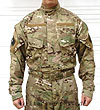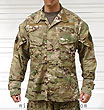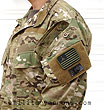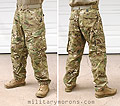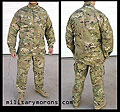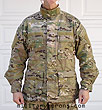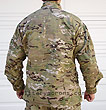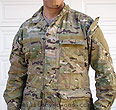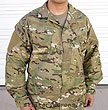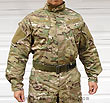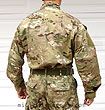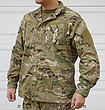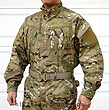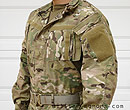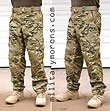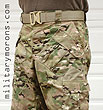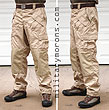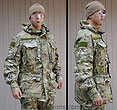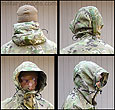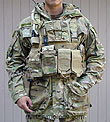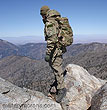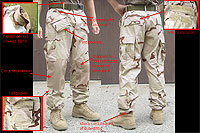Uniforms/Military Clothing page 1 page 2 page 3 page 4
TO VIEW FULL SIZE IMAGES: USERNAME and PASSWORD are both "mm"
| 5/2/08 -
TAD Gear now
has the companion top to their popular Force 10 Cargo Utility Cargo
Trousers; the Force 10 Utility Top. Constructed of the lighter weight
Crye Multicam 50/50 NYCO shirt weight twill, the TAD gear 'black label'
Force 10 top has a host of practical features, like the trousers,
and is made in the U.S.A.
Here's a rundown of the features on the Force 10's (size medium shown):
Like the Force 10 Cargo Utilities, construction and workmanship on the Utility Top is excellent, and it's a great match for the pants. |
TAD Gear Force 10 Cargo Utilities 2007
| 1/25/06 - TAD Gear has released the newest evolution of their popular Force 10 Cargo Utilities - the 2007 model in Crye MultiCam. Constructed of the 8.5oz MIL-PRF-MCCUU 50% Nylon 50% Cotton heavier weight twill (same as used on the Crye Precision Field pants), these TAD gear 'black label' Force 10's are laden with features and made in the U.S.A.
Here's a rundown of the features on the Force 10's (medium/short shown):
Construction and workmanship are excellent, as is the attention to detail; especially in the places that can't be seen, like inside the pockets. |
SKD Tactical MultiCam Enhanced BDUs (2007 Model)
| Updated 2/11/07 -
Ever since Crye Precision came out with their Field Uniform a couple
of years ago, there has been a demand for an alternative (due to either
pricing or availability of the Crye products) MultiCam uniform. Some
didn't want the extra features that the Crye Field Uniform offered,
and complained that the prices was too high. What they didn't take
into account is how expensive it is to have clothing made in the U.S.,
and in relatively small quantities when compared to a govt contract
BDU manufacturer and widely used patterns. Since then, some other
companies have produced MultiCam BDUs with various features (some
better than others), but there's very little difference in price between
them and Crye's. The Alpha, Bravo and Charlie models of the SKD Enhanced BDU Shirts share some common features. These are:
The differences between the Alpha, Bravo and Charlie models are in the pocket configurations on the body: Enhanced BDU shirt Alpha Model - The Alpha model has a four-pocket BDU configuration and is meant to be worn untucked. Button front version shown here.
Enhanced BDU shirt Bravo Model - The Bravo model shown here is the velcro-front closure variant. The lower pockets have been eliminated.
Enhanced BDU shirt Charlie Model - The Charlie model shown here has the button-front closure. The Charlie also eliminates the bottom front pockets. Like the Bravo, the Charlie model is meant to be worn under a vest or armour, hence the side-entry pockets.
BDU pant - The SKD Enhanced Combat Pant is based on standard mil-spec BDU pants in design and sizing. The Crye field pants have a shorter than normal rise (height between the crotch and waist), which suits me fine, but some didn't like as much. The SKD BDUs have a standard rise for those who like to wear their BDUs around the waist instead of just above the hips. Standard features of SKD's MultiCam pants are:
|
SKD Tactical Enhanced BDU Pants (Gen 2 - 2010)
| 2/6/10 - SKD Tactical's new Gen 2 Enhanced BDU pants are a follow-on to their Enhanced BDUs released two years ago. While the Gen 1 Enhanced BDU pants were based on the standard mil-spec BDU pant in style and sizing, the Gen 2's still retain the classic BDU cut and fit but with the addition of quite a few new features and changes. I've actually been wearing these since 2008 as it's taken quite a while for SKD to get these made. Unfortunately, due to slight manufacturing irregularities from pant to pant, SKD has decided to offer them at a deep discount, rather than full retail. Note: size Medium/short is shown here. I'm 5' 7" with a 29" inseam (short legs). Also note that the Khaki BDUs shown here are a pre-production pair, and the knee pad pocket material and edge tape for the pocket clip reinforcements will be changed to match better on the production model. The tan nylon on the knees have a slight 'satiny' sheen - the production ones are matte.
Features - Here a summary of the features on the SKD Tactical Gen 2 Enhanced BDU Pants:
Observations and Notes - One of the pairs of pants I was sent had one of the pelvis pockets sewn about 0.5" different than the other one. The two pairs shown here don't have any irregularities. I informed SKD of this, and they looked into it. Unforunately, some pants in the first production run displayed some of these irregularities, which don't affect functionality, so now the whole run is being offered at a deep discount. Other than that, overall quality is decent/good - on par with other govt contract BDUs. As with other BDUs I own, they're not finished as cleanly as some commercial pants (loose thread ends, and I usually burn off the loose thread ends with a lighter. Nothing that would affect functionality that I noticed. The Gen 2 Enhanced BDU pants are more of a blend between the BDU style and current 'tactical' pants on the market than a pair of military BDUs. Ken from EMDOM was one of the people consulted on this project, so it shares some of the features found on the EMDOM CBDU. The classic military 6-pocket BDU style is pretty firmly ingrained in our minds, and quite recognizable everywhere. These pants, due to the deviation in key features from that pattern, don't stand out as being overtly 'military', due in part to the smaller side cargo pocket and rear slash pocket profile. On the other hand, the front 'pelvis pockets' are more noticeable than welted besom pockets, and I've been asked about them a couple of times. All I say is that it's easier to reach your phone or sunglass case when seated because of the way they're angled (which is true) and that makes sense to most people. An M4 mag placed in the elastic there is very quick to draw and won't fall out during movement. It works best when the pants are worn alone, without a duty belt and thigh rig. I've mentioned in other writeups how much I utilize front besom, or in this case, pelvis pockets, and these are some of the most functional I've tried. I haven't found myself missing the larger side cargo pockets either (yet). The shorter ones work as advertised, and don't swing as much. The rear slash pockets are also easier to access than standard flapped pockets, but are theoretically not as secure as flap-closed rear pockets. You just have to make sure that the item you're putting inside is larger than the partially-secured opening. I've been wearing the prototype pants since about mid-November of 2008 for everyday wear at work (the khaki ones) and the MultiCam ones elsewhere, and they're a great fit and are comfortable. Definitely more so than my 5.11 pants. While they're supposed to have the same cut as standard BDUs, I've found the 'standard' to differ between manufacturers. Some are really baggy while others fit better. The SKD Enhanced BDU pants are of the less baggy cut, and they fit more like 'normal' tactical pants than baggy BDUs, which I like better. They have more than enough room in them for unrestricted mobility and range of motion. The waist/rise isn't too high either. The nylon on the knees is light enough that I don't notice it during daily wear. Granted, I started to wear these in the fall, but we've had a mix of hot and cold weather during that time and I didn't feel that my knees were feeling more stuffy than with other pants due to the nylon layer. The added abrasion resistance is definitely worthit, in my opinion, and the ability to insert foam pads. I prefer this Enhanced BDU style to regular BDUs as I found the layout and design of the pockets and the additional features to be more practical and suit my needs better. Update 2/14/10 - Here are the production versions - shown here are the khaki and OD green pants. The knee pocket on the khaki is now completely matte, and the fabric is colour-matched quite well on both colour pants.
|
| 8/12/05 -
Hailing from the Great White North in Oiler country is Drop
Zone Tactical in Edmonton, Canada. Drop Zone manufactures and
deals in all kinds of military gear and equipment, including load
bearing gear, cases, bags, packs and clothing, to name a few. If you're
looking for CADPAT stuff, check there first, as they're one of only
a few manufacturers licensed to make items in CADPAT. The Recce Smock is sized generously - meant to be worn
over other clothing as a shell. I usually wear a medium BDU top, and
the small Recce smock still leaves enough room for an insulating layer
underneath. DZ makes their smocks in a variety of patterns and colours
(shown here in Crye MultiCam), most using cotton-synthetic blend fabrics
which provide breathability and can be treated to be somewhat water
repellent. It won't keep you dry in a downpour, but then it wasn't
designed to be rain wear.
The Recce smock hood is well-designed and simple to adjust. It's roomy enough to fit over a helmet, and a velcro strap adjustment is used to shorten it when used without one. The adjustment strap is sewn to the back of the hood, and goes through a looploc at the base of the neck. The height of the hood is varied by adjusting the length of the strap. The hood opening is adjusted by a shock cord drawstring, by pulling on the ends on either side through the sewn-down cord locks. Tightening the hood can be done one-handed. I didn't illustrate it here, but the brim at the front of the hood can be folded back to form a channel, which keeps rain water from dripping off the front of the hood, diverting it to the sides instead. When not in use, the hood can be rolled down, where a tab originating from the inside base of the neck goes over it and buttons down in the back, securing the hood. I've mentioned how much I value pit zips, and the Recce Smock includes them of course. They're essential for ventilation and greatly increase the range of temperatures that a garment can be worn in. The Recce Smock's pit zips open up from the waist to past the armpits. The pit zip pulls are a bit small if you're wearing gloves, but it's a simple matter to tie on short 550 cord pulls if desired. If additional ventilation is needed, a 6" front opening access zipper is located beside the main zipper, behind the storm flap. It also allows some access to chest pockets on garments worn under the smock.
The large, bellows cargo pockets on each side of the
chest are covered by flaps, with tape-style Canadian military buttons.
A plastic D-ring is located at the top inside of each pocket, for
dummy cording items inside. Behind each of the chest cargo pockets
is an additional pocket with vertical zipper closure, accessed from
the middle of the chest. Inside each pocket is a pen pocket, angled
for easier access. A 6"x1" velcro strip for name tape is
sewn above the right chest pocket.
To better illustrate the internal features of the smock, I wore it inside out, as shown below. There are two large map pockets on each side of the chest with horizontal zip openings. These are accessed most easily by partially unzipping the top of the smock - it's a bit awkward to use the front ventilation opening. You can also see the waist shock cord and cord locks in the photos below. Following the ancestry of the poacher's pockets at the rear of the SAS smocks, DZ placed 3 deep, divided pockets in the rear, each with its own velcro closure. In general, they're used to store soft items.
Obviously, when you wear a rig over any garment, it will limit access to most of the torso or chest pockets, less so with a suspender/harness style LBE. I found that I was still able to access the lower cargo pockets while wearing a chest rig over the smock. If the smock is worn over a pistol belt with thigh holster or subload, they'll be covered up - same as with any full length parka. I've suggested adding zippers on the side seams to allow a 6" split, offering greater mobility and less interference with equipment and access to trouser pockets, but that has yet to be tested. If no access to the trouser pockets and you don't mind limiting access to the lower cargo pockets, the belt kit can simply be worn over the smock so that access to a holster or thigh rig isn't affected. At the time of this writing, it's been too hot to wear any kind of long sleeves during the day, so I'll have to wait a few months to get the smock dirty. I was pleasantly surprised to find that the smock isn't as hot or stuffy as I thought it would be, due to the breathable nature of the material and the ventilation provided by the pit zips. Kudos to Drop Zone Tactical for making a classic combat garment even better. 9/10/05 - Went on a hike with the wife today, starting out at an elevation of 6000', going up to 10,000' and back down again. Even though this is the end of summer, it's always windy up at the summit, and it was quite chilly today. I packed along the Recce Smock instead of a civvie windbreaker/jacket as it's been too hot to wear it anywhere else and I was just itching to use it. I put it on before we got to the top when the wind started blowing hard. Worked wonderfully, and was comfortable to wear with the Kifaru Express I had. The pit zips really do help broaden the useful temperature range of this garment. Plus I think it looks dead sexy.
|
 Main features of RAID BDU top |
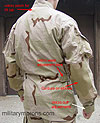 RAID top back features |
|
RAID SHIRT
RAID PANTS
The SWG RAID BDUs are made as a result of demand from customers.
They're not cheap, but when you consider that each one is hand tailored
to order, and you add up the time it takes to make all the modifications
and add the features, it doesn't seem that bad. Proppers aren't
my favourite brand, but they're allright and I've no complaints
with this set. I really like all the added features, and realize
that they may be deemed unnecessary by some. That's ok, and modified
BDU's aren't needed by all. But some of the additional features
might work well for some, and the RAID BDUs would be a worthy consideration. |
ATTENTION! PLEASE DO NOT LINK DIRECTLY TO MY IMAGES
-
IT RESULTS IN MY BANDWIDTH ALLOCATIONS BEING EXCEEDED,
AND MY PAGES GO DOWN. THANKS!
/ . PLEASE
OBSERVE AND RESPECT OUR COPYRIGHT! . /
©opyright by MilitaryMorons.com. All Rights Reserved. Reproduction, Duplication,
Distribution Strictly Prohibited.
Unless mentioned otherwise, content and images are the
property of militarymorons.com and are not in the public domain.
They are not to be used without
permission. Please Contact
me for permission to use any images or content herein.
